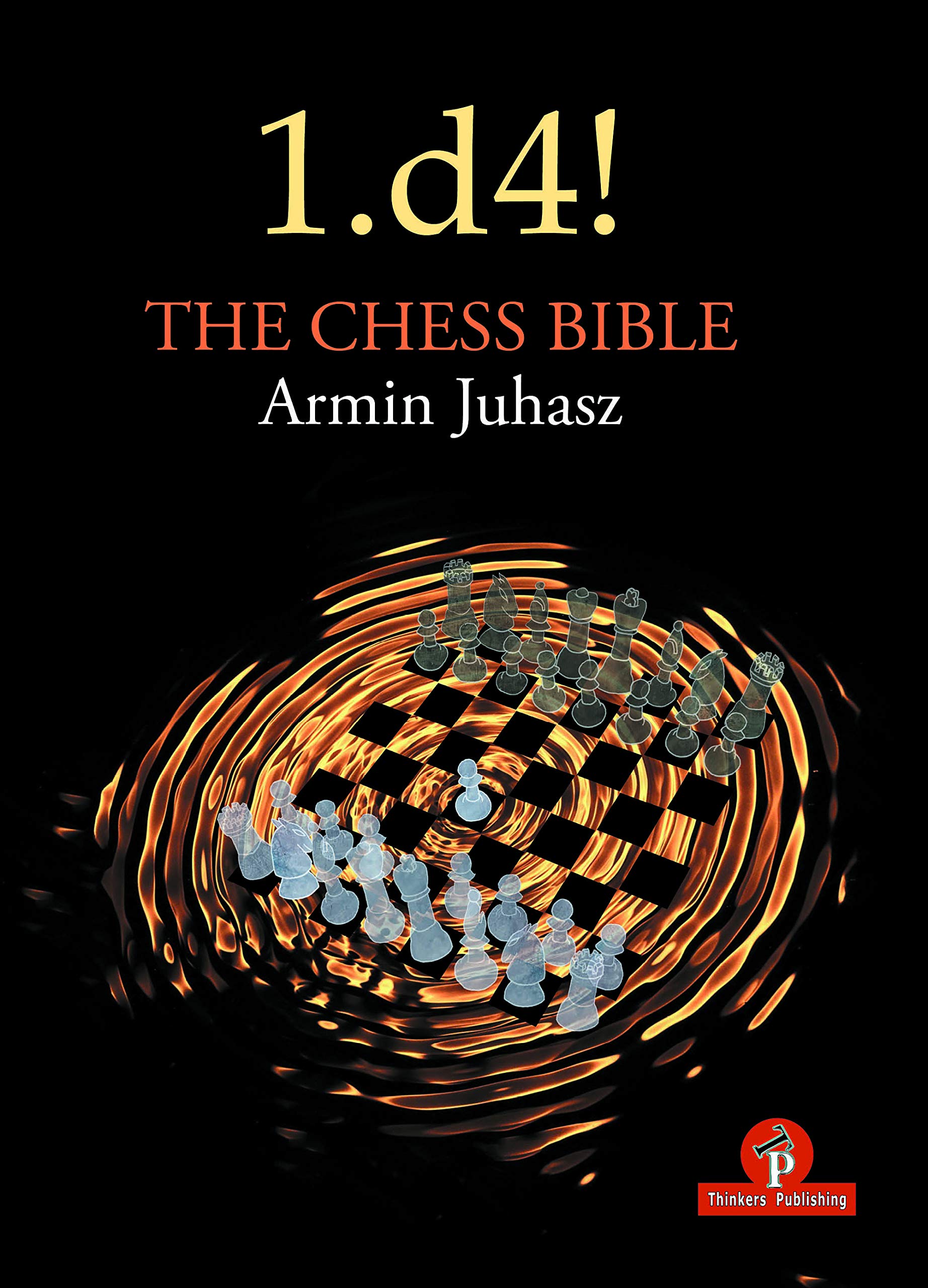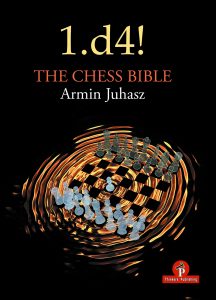Daily Archives: April 27, 2021
1.d4! : The Chess Bible : Understanding Queen’s Pawn Structures

From the publisher:
“In his first book (we anticipate many more), the young Hungarian author makes a worthy attempt to walk his readers through a complete 1.d4 opening repertoire. Yet while he is taking you thru the opening he never forgets the other phases of the game. As a result, the subsequent middlegame and endgame elements are remarkably well organized benefiting both beginner and advanced players to acquire powerful skills with 1.d4!”

“Europe’s youngest FIDE accredited trainer, IM Armin Juhasz, is an active player and a successful coach living in Budapest, Hungary. Born in 1998 he is currently 22 years of age and earned the IM title when 17. In 2016 he achieved his highest Elo of 2424. Armin has twice won the Hungarian Youth Championship. He was a member of the Hungarian U18 team which won the silver medal at the European Youth Team Championship in 2016. In addition to being an active competitor he is also the owner and CEO of Center Chess School. This thriving start up effort in Budapest has seen outstanding results. Several of his students have won numerous medals on both the world and national stage. Included in this list of success are two Hungarian Championships, on in the U16 and the other in the U14 division. He has also coached a World U12 Champion from the United States.”
End of blurb.
As with every recent Thinkers Publishing publication high quality paper is used and the printing is clear. We were hoping that the excellent glossy paper of previous titles would be used for this one but never mind.
With a small amount of persuasion the book can be laid flat next to the board and does not require weights to prevent it from “self-closing” (a particular bugbear of ours !). Each diagram is clear and the instructional text is typeset in two column format, which, we find, enables the reader to maintain their place easily. Figurine algebraic notation is used throughout and the diagrams are placed adjacent to the relevant text and each diagram has a “to move” indicator and a “position after: x move” type caption.
There is no Index or Index of Variations but, despite that, content navigation is relatively straightforward.
The main content is divided into six chapters :
- The King’s Indian Defense
- The Grünfeld Defense
- The Benoni Defense
- The Slav Defense
- The Catalan Opening
- Frequent Endgame Types
Pedant warning: before we look at the important stuff you might have noticed above the above use of “defense” rather than “defence”. This is the spelling used throughout which we are surprised that the editor/proof readers/typesetter allowed through. We will shall not dwell further on this. The rear cover (but the not the preface) introduction by GM Horvath uses the horrible “thru” instead of “through”. Moving on…
Our first attempt at reviewing was to hit the buffers and this was caused by wording within the Preface (and rear cover text) from GM Horvath. He writes
the young Hungarian author makes a worthy attempt to talk his readers through a complete 1.d4 opening repertoire,
Complete? This did not fit with the above chapter listing (unless the definition of “complete” has recently been updated. Seeking clarification we consulted Thinker’s Publishing and they confirmed that the word “complete” was indeed employed erroneously by Horvath. In fact, the sub-title (which does not appear on the front or rear covers) of “Understanding Queen’s Pawn Structures” we were informed should have been given greater prominence. Moving on…
So what we actually have here is a partial repertoire for White against the five Black defences listed above plus an intriguing sixth bonus chapter. Each of the five chapters selects a line for White and proceeds to help you understand that recommendation using the same methodology (which appears to be both novel and sensible) as follows:
For each of chapters 1-5 we have sections:
- Introduction
- Model Games (I)
- Theoretical Section
- Model Games (II)
- Typical Tactics
- Homework
- Concluding Tips
Interestingly Model Games (I) provides annotated games that are not in the line for White suggested but important stem games for the Black defence providing extra background about the typical plans and structures for Black that you should be aware of.
Theoretical Section gets down to the nitty gritty of detailed variations and analysis. Model Games (II) is not more of the same of (I) but model games that are directly from the recommendations contained in the Theoretical Section. Thinking back over the history of opening books for many of them this would have been the only style of content. Things have evolved for the better.
Typical Tactics is a collection often repeating tactical ideas and themes directly arising from these variations and therefore very relevant.
Homework sounded a little weird (to us at least) since surely all of the above are examples of homework? However the point of these sections is interesting. The book provides the reader / student with half a dozen or so high quality games that are devoid of any notes or annotations. The student is invited to play through these games on a real chessboard (!), make notes, identify critical moments and find potential improvements for both sides. Finally, the student should check their work with an engine.
Finally, each chapter ends with Concluding Tips which is a series of bullet points that should be taken away.
We could end this review here and now but perhaps mention of some chess would be welcome?
Rather than tediously listing all of the recommendations of each chapter the BCN office staff chose the Slav chapter to dip into.
The author’s fourth move recommendation for White is perhaps not one you would have even considered. This is good since it means almost certainly neither will have your opponent!
Yes, 4.g3 which is an unpretentious little move but appears 4527 times in Megabase 2020 compared with 83884 times for the more familiar 4.Nc3.
4.g3 scores a decent 57.5% at all levels at 56.5% with the Top Games option enabled.
By comparison 4.Nc3 scores 57% and 58.6% respectively.
If you would like to see some sample pages from the book then click here.
If you would like to know all of the other recommendations then you will have to buy the book!
Possibly, the most interesting and novel chapter of all is the final one, Frequent Endgame Types. Nine games are provided starting as the middlegame ends and annotated in detail. Strong players will select openings based on a structure they like and understand and potentially because of the endgame it is likely to provide.
Here is an example of a provided game (the book annotations start at move 33):
In summary, if you play 1.d4 then this book will provide a unique insight into many typical structures and plans and if you play the King’s Indian, Grünfeld, Benoni, Slav or the black side of the Catalan then this book will be beneficial.
In many ways this book has provided a fresh approach to teaching openings and, tells us a great deal about the author in the process.
It is clear as daylight that IM Armin Juhasz is a talented trainer and author with a great passion for teaching. We are convinced that his time must be in high demand!
We think you will enjoy this book and derive benefit from it.
John Upham, Cove, Hampshire, 27th April, 2021

Book Details :
- Hardcover : 280 pages
- Publisher:Thinkers Publishing; 1st edition (12 April 2021)
- Language: English
- ISBN-10: 9464201118
- ISBN-13: 978-9464201116
- Product Dimensions: 17.02 x 23.5 cm
Official web site of Thinkers Publishing

